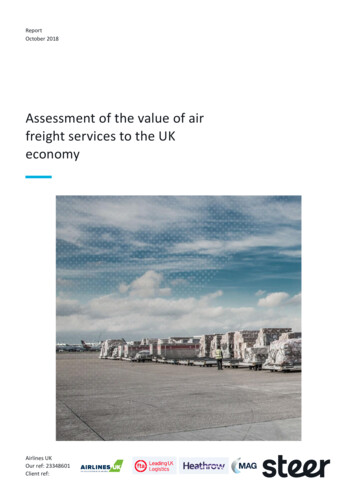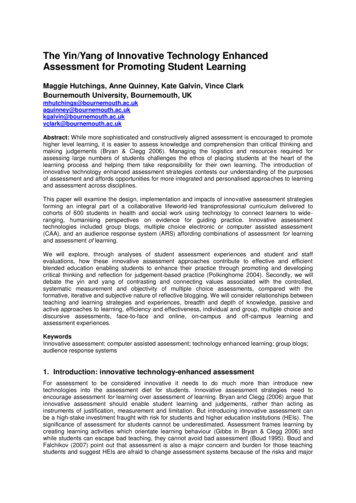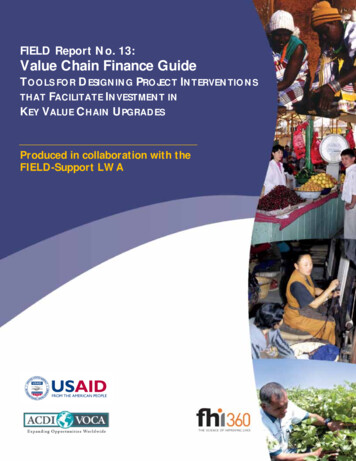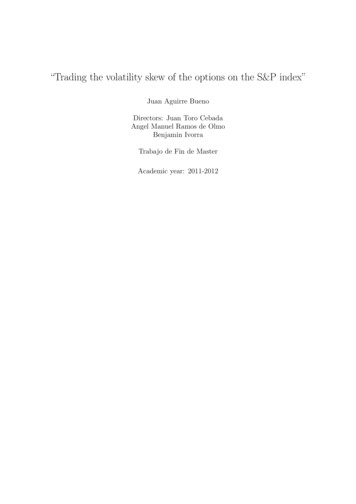
Transcription
ReportOctober 2018Assessment of the value of airfreight services to the UKeconomyAirlines UKOur ref: 23348601Client ref:
ReportOctober 2018Assessment of the value of air freightservices to the UK economyPrepared by:Prepared for:Steer28-32 Upper GroundLondon SE1 9PDAirlines UK25 Southampton BuildingsLondonWC2A 1ALClient ref:Our ref: 23348601 44 20 7910 5000www.steergroup.comSteer has prepared this material for Airlines UK. This material may only be used within the context and scope forwhich Steer has prepared it and may not be relied upon in part or whole by any third party or be used for anyother purpose. Any person choosing to use any part of this material without the express and written permission ofSteer shall be deemed to confirm their agreement to indemnify Steer for all loss or damage resulting therefrom.Steer has prepared this material using professional practices and procedures using information available to it atthe time and as such any new information could alter the validity of the results and conclusions made.
Assessment of the value of air freight services to the UK economy ReportContentsExecutive Summary . iBackground. iKey figures . iIndustry structure . iMarket Analysis .iiInternational Trade.iiiEconomic analysis. iv1Introduction. 1Background. 1Our Approach . 1This Report . 12Industry structure . 2Overview. 2Air freight markets. 3Air freight business models . 4Trucked freight . 6Structural constraints . 6Case Study – Consumer electronics imports . 10Policy considerations . 113Market Analysis . 12Overview of air freight volumes . 12Destinations. 14Case Study – Heathrow and the Scottish salmon industry . 16Volumes at regional airports . 17International comparisons . 20Case study - Aerospace. 22Policy considerations . 234International Trade . 24Role of air freight in UK trade . 24Geographical markets . 26October 2018
Assessment of the value of air freight services to the UK economy ReportProduct markets . 29International comparisons . 31Case Study – Pharmaceutical exports . 33Policy considerations . 345Economic analysis . 35Introduction . 35Direct, indirect and induced impacts . 36Wider economic impacts . 39Regional economic impacts . 44Case study – Connectivity at Manchester Airport . 47Policy considerations . 49FiguresFigure 2.1: Typical end to end journey: interaction between markets and business models. 3Figure 2.2: Typical end to end journey: Freight forwarder . 5Figure 2.3: Typical end to end journey: Integrator forwarder . 5Figure 3.1: Freight volumes at six largest UK airports, tonnes (2017). 12Figure 3.2: UK freight volumes, Million Tonnes (2002-2017) . 13Figure 3.3: Destination of UK freight volumes, Million Tonnes (2017) . 15Figure 3.4: Indexed growth of freight volumes at selected UK airports, 2002 100 (2002-2017). 17Figure 3.5: Glasgow: Departing frequencies and bellyhold freight volumes (2002-2017) . 18Figure 3.6: Birmingham: Departing frequencies and bellyhold freight volumes (2002-2017) . 18Figure 3.7: Manchester: Departing frequencies and bellyhold freight volumes (2002-2017) . 19Figure 3.8: Relative freight volumes at 20 largest EU airports (2017). 20Figure 3.9: Freighter and bellyhold volumes at four largest European airports, Million Tonnes(2017) . 21Figure 3.10: Indexed growth of selected EU countries freight volumes, 2008 100 (2008-2017). 21Figure 4.1: Air transport’s share of total export and import value, Billion (2017) . 24Figure 4.2: Average value of goods transported by each mode, /kg (2017) . 25Figure 4.3: Air transport’s share of trade value with largest non-EU trading partners, Billion(2017) . 25October 2018
Assessment of the value of air freight services to the UK economy ReportFigure 4.4: Volume of air exports and imports with top 15 non-EU trading partners, 1,000tonnes (kt) 2017) . 27Figure 4.5: Value of air exports and imports with top 15 non-EU trading partners, Billion(2017) . 28Figure 4.6: UK non-EU exports and imports at a 2-digit SITC code level, 1,000 tonnes (kt) (2017). 29Figure 4.7: UK non-EU exports and imports at a 2-digit SITC code level, Billion (2017). 30Figure 4.8: Largest traded product groups at a 2-digit SITC code level, Billion (2017) . 31Figure 4.9: Air transport’s share of export value in top 10 EU export markets, Billion (2017) 31Figure 4.10: Air transport’s share of import value in top 10 EU import markets, Billion (2017). 32Figure 4.11: Proportion of trade value transported by air between selected EU and non-EUcountries (2017). 33Figure 5.1: Measures of economic impact . 36Figure 5.2: Direct, indirect and induced economic impacts . 36Figure 5.3: Estimation of industry output exported using air freight . 40Figure 5.4: Illustration of relationship of industry output and GVA related to exports by air, Billions. 42Figure 5.5: GVA currently dependent on air freight by industry, Billion . 44Figure 5.6: GVA currently dependent on air freight by region, Billion . 45Figure 5.7: Proportion of GVA currently dependent on air freight by region and industry . 46TablesTable 2.1: UK airport night-time operating restrictions . 7Table 5.1: Air freight and supporting services . 38Table 5.2: Air freight multiplier effects. 38Table 5.3: Economic impact of air freight services . 38Table 5.4: Industry sector induced effects multipliers . 42October 2018
Assessment of the value of air freight services to the UK economy ReportExecutive SummaryBackgroundThis study has been produced by Steer for Airlines UK with support from Heathrow AirportLimited, Manchester Airports Group and the Freight Transport Association. It has beenundertaken in the context of the UK Government developing its Aviation Strategy, due forpublication in Summer 2019, with a Green Paper expected in December 2018. As part of thisprocess, the Government is consulting stakeholders to identify barriers to growth and how toreduce them. While many high value-added industries make significant use of air freight, thereremains limited understanding of the role of air freight within the UK economy. The purposeof this study is to assess and quantify the value of the air freight industry to the UK economy,and in particular, its importance to UK regions, international trade and industrial sectors.Key figures Air freight services contribute 7.2 billion to the UK economy and support 151,000jobs.Across all sectors of the economy, 87.3 billion of UK gross value added (GVA) iscurrently dependent on air freight exports, including a very significant proportion ofthe GVA of some key industries and their supply chains:– Pharmaceuticals - 13.9 billion– Computer, electronic & optical - 8.3 billion– Creative arts & entertainment - 5.3 billion.In 2017 air freight represented 49% of the UK’s non-EU exports by value ( 91.5 billion)and 35% of non-EU imports ( 89.9 billion) - over 40% of total trade by value but under1% by volume of goods shipped.Germany ships just 25% of its non-EU export value by air, and most other major EUeconomies ship between 20% and 40%. Only Ireland ships a greater share of its nonEU exports by air than the UK.9% of GVA in the North West (worth 14.9bn) is currently dependent on air freightservices, compared to less than 2% of London’s output. Figures are 8.6% in Wales,7.6% in the East Midlands and 6.8% in the South West.Industry structureThe air freight industry is complex and highly fragmented. The four major sub-markets withinair freight are General cargo, Express, Specialist and niche products and Mail. Although theindustry is complex and business models overlap, two principal business models serve all fourmarkets; the forwarder model and the integrator model.These business models dominate the UK’s major air freight airports: Heathrow, East Midlands,Stansted and Manchester. Heathrow is by far the largest general air freight market using theforwarder business model and the overwhelming majority of cargo is transported in thebellyhold of passenger aircraft, mostly on long-haul routes. East Midlands, by contrast, isdominated by express freight using the integrator business model, with freight carried infreighter aircraft, often overnight on routes to mainland Europe, but also on intercontinentalroutes. Stansted has a combination of integrators and other freighters, while Manchester islargely bellyhold, although on a much smaller scale than Heathrow.October 2018 i
Assessment of the value of air freight services to the UK economy ReportOne notable feature of the UK air freight market is the huge importance of Heathrow and itssurrounding freight facilities, with most forwarders having major consolidation centres in thevicinity of the airport. Very significant volumes of air freight are trucked to such facilities nearHeathrow, processed and then trucked to another airport, either in the UK or in continentalEurope, without ever flying in or out of Heathrow itself.Night operating restrictions, based on movement limit and noise quota systems, are currentlyin place at Heathrow, Gatwick and Stansted, while other airports have to produce noise actionplans which may set out operating limits for the night period. There is also an additional noisequota limit incentivising the user of quieter aircraft.The quality of the UK’s air freight infrastructure is a major issue, with freight facilities at UKairports often being decades old and having suffered from continued under-investment. Whileother airports are not as slot congested as Heathrow, they now cater to significantly morewidebody freight capacity than the facilities were originally designed for.Although the terms of the UK’s exit from the EU are still being negotiated, withdrawal fromthe EU has the potential to affect the UK freight industry through changes to customsarrangements and changes to air services agreements (ASAs).This analysis of the structure of the air freight industry raises a number of issues relevant tothe formulation of national aviation policy. These include: the positive and negative aspects of the concentration of the air freight industry at andaround Heathrow;the quality of infrastructure supporting air freight services;the balance of the impacts of night and noise restrictions on local residents and air freightservices;the potential for growth of air freight services at airports outside the South East ofEngland; andthe management of the potential impacts of Brexit.Market AnalysisBellyhold cargo at Heathrow accounted for over 60% of total UK air freight volume in 2017,with forwarders and shippers utilising its extensive intercontinental passenger network. Over30% of total air freight was shipped on US routes and most of the remainder on Asian routes.Freighter and integrator cargo is concentrated at East Midlands and Stansted, which, in 2017,together accounted for over 20% of all UK freight and the majority of freighter (60%) andintegrator (79%) activity. Integrators accounted for over 90% of freight at East Midlands. AtStansted, integrators FedEx and UPS were the largest cargo airlines, although intercontinentalfreighters such as Qatar Airways, Cargolux and China Southern also accounted for a large shareof volume.In the last 15 years, aside from the decline in 2009 due to the fallout from the financial crisis,total volumes have remained relatively flat, growing with a compound average growth rate(CAGR) of 1.2% over the 15-year period with volumes only surpassing the pre-crisis peak in2016.North America was the largest destination market (accounting for 32% of volume), followed byEurope (25%, 18% of which was to the EU) and, South and East Asia (19%). Heathrow, and to alesser extent Gatwick, handled predominately North American and Asian freight, benefittingfrom extensive passenger networks. The large European share of volume at East MidlandsOctober 2018 ii
Assessment of the value of air freight services to the UK economy Reportreflects the airport’s role within its integrators’ networks. Similarly, at Stansted, much of thefreight volume is on European and North American routes.A relatively large share of many regional airports’ volume (including Manchester, Birmingham,Glasgow and Newcastle) is accounted for by Middle Eastern routes, reflecting the importanceof the Gulf carriers’ networks to these airports’ freight operations. Airports in Scotland andNorthern Ireland, such as Aberdeen, Belfast and Edinburgh, have a relatively large share ofdomestic volumes, which is likely to be because trucking to other parts of the UK from theselocations is less time-effective.Although Heathrow is one the largest airports in the EU in terms of freight volumes, due to itsslot and operating constraints described above, it has a significantly lower amount of freighteractivity compared to other major European hub airports.As air freight has started to grow again after several years of stagnation, the increasingvolumes and longhaul connections at major airports outside the South East of England as wellas the prospect of the third runway bringing additional capacity at Heathrow, give rise to anumber of policy issues for consideration, including: how to make best use of existing infrastructure and unlock more capacity throughinvestment in air freight facilities at UK airports;how to manage the air freight implications of the third runway at Heathrow; andhow to support the air freight sector to grow sustainably.International TradeIn 2017, non-EU trade classified as being transported by air accounted for over 40% in terms ofvalue but under 1% of total trade in volume terms (with sea accounting for over 98%). Airfreight represented 49% by value of non-EU exports ( 91.5 billion) and 35% by value of non-EUimports ( 89.9 billion).Many of the products with a high share of UK trade value transported by air, such as aircraftengine parts and power generating machinery, have a high share of both import and exportvalue, likely reflecting the global nature of these industries’ supply chains and manufacturingprocesses. One exception is pharmaceuticals, which account for a significant proportion ofexport (but not import) value.It is also interesting to compare the UK’s use of air freight for its exports and imports againstother European countries. Although Germany is by far the largest EU exporter to non-EUcountries, only 25% of its goods by value are transported by air, whereas the UK, which hasthe second largest total export market, ships a far higher proportion (49% by value) by air.Most of the other major EU economies ship between 20% and 40% of the value of their nonEU exports by air; only Ireland (64%) ships a greater share of its non-EU exports by air than theUK.On the import side, the UK is the second largest market in the EU and has the highest share ofimports transported by air, which makes its imports by air ( 90 billion) the most valuable inthe EU. Like the UK, most other major European economies ship lower proportion of theirnon-EU imports (compared to exports) by air, with most importing 10% to 30% by air in valueterms.The importance of air freight to UK international trade, and in particular the UK’s higherdependence on air freight than most other countries raises issues for consideration in theOctober 2018 iii
Assessment of the value of air freight services to the UK economy Reportdevelopment of the UK Government’s Aviation Strategy on the appropriate level ofGovernment support for the air freight sector and how its importance should be reflected aspart of the strategy for the aviation sector as a whole.Economic analysisWe have used two different, complementary, approaches to assessing the economic value ofair freight: the traditional measure of economic impacts on employment, income and GVA of the airfreight industry and associated services, generally known as “direct”, “indirect” and“induced” impacts (based on the activity in the sector itself and on upstream monetaryflows between the air freight industry and other sectors in the economy); andthe wider economic impacts of air freight, sometimes referred to as “catalytic impacts”,which consider how air freight facilitates economic activity in other sectors (based, in thiscase, on estimating what proportion of GVA in those sectors is currently reliant on airfreight services).Using the traditional approach, we have estimated the “direct”, “indirect” and “induced”impacts using a recognised methodology based on the use of Input-Output tables (I-O tables),produced by the Office for National Statistics (ONS). Direct impacts relate to the employment,income and GVA generated by the sector itself, indirect impacts take account of the knock-oneffects in the sector’s supply chain, while induced impacts also include the impacts ofemployees’ spending in the economy. These can be calculated from the I-O table, byinspection for direct impacts and via standard techniques for the indirect and induced impacts.Including all of these impacts, we estimate that air freight services support GVA of 7.2 billion,151,000 jobs and associated income of 4.1 billion (2014 data and prices).Note that this result only relates to activities and expenditure either within the air freight andsupporting industries, its supply chain and spending by its workforce. It does not include“downstream” effects, i.e. the effect on the industries purchasing air freight services, or thewider, catalytic, impacts on the whole economy. To estimate these, we have used an approachbased on the fact that supplying air freight services does not fully represent either the value ofwhat is being flown, or the value of timely delivery. In terms of the value of what is flown, airfreight imports and exports, between them, were worth 181 billion (2017 values and prices) ,or close to 25 times more than the economic added value (GVA) calculated using the direct,indirect and induced methodology described above.Each sector of the economy produces outputs for which customers are willing to pay, withprimary and secondary sectors producing physical products such as food, machine parts, carsand so on. For these sectors of the economy, their outputs equate to particular commoditiesso that, for example, farms produce agricultural products while automotive plants producecars and trucks. Hence, there is a correspondence between each industry and its outputs. Byusing this correspondence (together with information on exports by air from HMRC, and incomparison with output from ONS), we can establish, for each industry producing physicaloutputs, what proportion of those outputs is represented by exports transported using airfreight services.It is reasonable to make the assumption that all output contributes equally to the GVAgenerated by an industry. We have also made the assumption that the proportion of anindustry’s GVA supported by air freight services is equal to the proportion of its outputs whichOctober 2018 iv
Assessment of the value of air freight services to the UK economy Reportare exported by air. The final step in this analysis is to recognise that, if a portion of anindustry’s GVA is dependent on air freight services, then the suppliers who provide inputs tothat industry are also dependent on the air freight services.Using this approach, we have estimated the level of GVA currently dependent on air freightacross the economy. Across all sectors of the economy, 87.3 billion of GVA is currentlydependent on air freight exports. This represents 5% of the total GVA measure of nationaloutput ( 1,747 billion in 2016).While the level of GVA currently dependent on air freight might potentially be reducedthrough the use of alternative modes of transport, the fact that such alternatives are generallypoor substitutes for air freight, which is both much faster and much more expensive thansurface freight, indicates that the level of GVA dependent on air freight is likely to remainsignificant. This indicates that air freight is a very important service supporting a significantfraction of national economic activity.The analysis of the level of industries’ and their supply chains’ added value (GVA) which iscurrently dependent on air freight, enables us to estimate the regional importance of airfreight services, by considering the regional distribution of output for each industry.This analysis demonstrates the importance of the air freight industry in the North West, where 14.9 billion of GVA is currently dependent on air freight, representing 9.0% of the wholeeconomy of the region. Similarly, air freight supports very significant proportions of economicactivity in many regions, including 8.6% in Wales, 7.6% in the East Midlands, 6.8% in the SouthWest, 6.0% in the West Midlands and 5.9% in Northern Ireland. The contrast between the veryimportant role of Heathrow in providing air freight services, compared with the highdependence of regions away from the South East economies on air freight, is stark.Considering both the industry structure and this economic analysis raises particular issuesrelevant to the formulation of national aviation policy as the UK Government develops anaviation strategy towards 2050: how to protect and develop the significant share of the UK economy currently dependenton air freight services; andhow to support UK regions and nations whose economies are heavily dependent on airfreight services, particularly where local airports do not currently benefit from strong airfreight services.October 2018 v
Assessment of the value of air freight services to the UK economy Report1IntroductionBackground1.1This study has been produced by Steer for Airlines UK with support from Heathrow AirportLimited, Manchester Airports Group and the Freight Transport Association. It has beenundertaken in the context of the UK Government developing its Aviation Strategy, due forpublication in Summer 2019, with a Green Paper expected in December 2018. As part of thisprocess, the Government is consulting stakeholders to identify barriers to growth and how toreduce them. While many high value-added industries make significant use of air freight, thereremains limited understanding of the role of air freight within the UK economy. The purposeof this study is to assess and quantify the value of the air freight industry to the UK economy,and in particular, its importance to UK regions, international trade and industrial sectors.Our Approach1.2To undertake this assessment, we have undertaken a review of the available literature, withdata and information gathered from the following sources: 1.3The Civil Aviation Authority (CAA);The Department for Transport (DfT);Her Majesty’s Revenue and Customs (HMRC);The Office of National Statistics (ONS);Eurostat;The Official Airline Guide (OAG);The United Nations Statistic Division (UNSD); andIndividual airport traffic statistical releases.In addition, we have held interviews and received data from industry stakeholders, including: Passenger airlines (UK and foreign);Integrators;Cargo airlines;Airport operators;Freight industry trade bodies; andUK-based companies using air freight.This Report1.4The remainder of this report is structured as follows: 1.5Chapter 2 gives an overview of the air freight industry in relation to markets, businessmodels and constraints;Chapter 3 describes the UK freight industry in relation to freight volumes;Chapter 4 describes air freight’s role in international trade; andChapter 5 provides a quantification of the economic contribution of air freight.Illustrative case studies have also been p
the quality of infrastructure supporting air freight services; the balance of the impacts of night and noise restrictions on local residents and air freight services; the potential for growth of air freight services at airports outside the South East of England; and the management of the potential impacts of Brexit.











